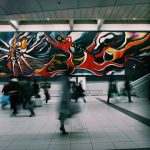Hello fellow readers and welcome to our new blog! We are really excited to tell you everything we know about Japanese arts and the artistic traditions of the island of Kyūshū. If you don’t know anything about Kyūshū or its art scene, you visited the right page as we are about to give you a quick rundown.
How Kyūshū Developed Art
Kyūshū is the southernmost island of Japan’s four main islands. It’s the island closest to the Asian continent and it’s surrounded by the East China Sea and the Pacific Ocean, both of which established it as the gateway to Japan and made it a centre of cultural exchange.
Kyūshū art, consequently, exhibits a plethora of different influences, combining the old traditions of Japan with those of the countries it interacted with over the centuries.
Kyūshū prides itself on its unique art and its diversity, and that could be everywhere on the island, from the buildings inspired by Portuguese architecture to modern animation exhibiting the influence of American art.
In fact, the National Museum of Kyūshū has a permanent exhibit with sections dedicated to exploring how other nations contributed to the development of uniquely Kyūshū art. Read our article on the museum to find out more.
Major Art Attractions in Kyūshū
In order to show you exactly how interesting and diverse in art the island of Kyūshū is, we will give you a few recommendations for places you can visit.
- Dazaifu Tenmangu Shrine, Dazaifu – The Dazaifu Tenmangu Shrine is the most significant Tenmangu temple, alongside Kyoto’s Kitano Tenmangu. It honours the spirit of Sugawara Michizane (Tenjon) who is the deity of learning, culture and art. As such, it’s the best first stop on your art tour of the island. The temple exemplifies the Japanese art tradition through the architecture and the Japanese beliefs surrounding art itself.
- Senganen Garden, Kagoshima – One of the best ways to learn about Japanese art practices is by visiting a traditional garden, showcasing the care and patience it goes in keeping every bit of flora perfectly trimmed. The Senganen Garden dates back to 1658, created by the Shumazu Clan that ruled Kagoshima for seven centuries. You can also visit their former residence which is on the estate.
- Dozaki Church, Fukue island – The Dozaki Church was built by two French priests in the late 19th century after the ban outlawing Christianity in Japan was lifted. This is one of the oldest Western-style Japanese churches and it’s located in the Goto Islands (Fukue) where Japanese Christians migrated in the past to avoid persecution. The church is not active, now it serves as a museum detailing the history of Christianity on the island.
- Glover Garden, Nagasaki – Glover Garden is the former estate of Scottish merchant Thomas Glover. Glover built the mansion in 1863, combining the popular Western colonial style with noticeable Japanese influence. The gardens feature statues of Italian composer Giacomo Puccini and Japanese opera singer Tamaki Miura who played the role of Madame Butterfly in his eponymous opera set in Nagasaki.
- Mifuneyama Rakuen, Takeo City – Mifuneyama Rakuen is a millennia-old forest, featuring a 3,000 years old sacred tree. Due to the sacral nature of the forest, a team of visual artists from all around the world collaborated on a project called “A Forest Where Gods Live”. The brilliant high-tech installations provide a new way to engage with nature, while the international collaboration is a love letter to Kyūshū diverse artistic traditions.
Conclusion
Kyūshū is as colourful as the many artistic influences that inspired its art. We hope you enjoyed reading our brief introduction into Kyūshū art and we hope you will enjoy learning more about the many wonderful places you can visit on the island and the fascinating art exhibitions you can go to.


